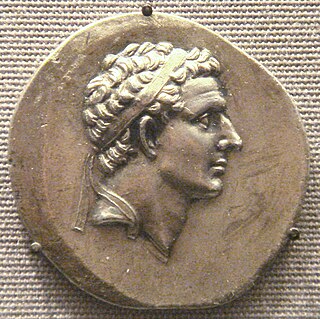
Segesta was one of the major cities of the Elymians, one of the three indigenous peoples of Sicily. The other major cities of the Elymians were Eryx and Entella. It is located in the northwestern part of Sicily in Italy, near the modern commune of Calatafimi-Segesta in the province of Trapani. The hellenization of Segesta happened very early and had a profound effect on its people.
In Greek mythology, Rhodos/Rhodus or Rhode, was the goddess and personification of the island of Rhodes and a wife of the sun god Helios. The poet Pindar tells the story, that when the gods drew lots for the places of the earth, Helios being absent received nothing. So Helios, with Zeus' consent, claimed a new island (Rhodes), which had not yet risen from the sea. And after it rose from the sea he lay with her and produced seven sons.
In Greek mythology, Antiphates is the name of five characters.

Diodorus Siculus or Diodorus of Sicily was an ancient Greek historian. He is known for writing the monumental universal history Bibliotheca historica, much of which survives, between 60 and 30 BCE. It is arranged in three parts. The first covers mythic history up to the destruction of Troy, arranged geographically, describing regions around the world from Egypt, India and Arabia to Europe. The second covers the Trojan War to the death of Alexander the Great. The third covers the period to about 60 BC. Bibliotheca, meaning 'library', acknowledges that he was drawing on the work of many other authors.

Sybaris was an important city of Magna Graecia. It was situated on the Gulf of Taranto, in Southern Italy, between two rivers, the Crathis (Crati) and the Sybaris (Coscile).
The Wars of the Diadochi, or Wars of Alexander's Successors, were a series of conflicts fought between Alexander the Great's generals over the rule of his vast empire after his death. They occurred between 322 and 281 BC.

Orophernes Nicephorus was one of the two sons Antiochis pretended to have had with Ariarathes IV, the king of Cappadocia because she failed to have children. However, she then did bear a child, Mithridates, and told her husband about the fake sons. These were sent to Rome and Ionia respectively to avoid a succession dispute with the legitimate son, whose name was changed to Ariarathes and who succeeded his father as Ariarathes V in 163 BC. A few years later Orophernes deposed him with the help of Demetrius I Soter, who became the king of the Syria-based Seleucid Empire in 161 BC when he overthrew Antiochus V, an underage king, and his regent, Lysias. The reign of Orophernes was short-lived. The Romans restored Ariarathes V.
Sybaris on the Traeis was an ancient city of Magna Grecia situated on the Traeis river, now known as the Trionto. It shares its name with the original city of Sybaris which was destroyed in 510 BC. Its former inhabitants built a new city, Thurii, not far from the site of Sybaris. This new colony was founded together with other Greek settlers in 446/445 BC. Soon a conflict arose between the two groups and most of the Sybarites were killed by the other Greek colonists of Thurii. The Sybarites who managed to flee then founded Sybaris on the Traeis a short time after 444 BC. The city was destroyed by the Bruttii not long after their emergence as an ethnic group in 356/355 BC.

The Italian wall lizard, ruin lizard, or İstanbul lizard is a species of lizard in the family Lacertidae. P. siculus is native to Bosnia and Herzegovina, Croatia, France, Italy, Serbia and Montenegro, Slovenia and Switzerland, but has also been introduced to Spain, Turkey, and the United States. P. siculus is the most abundant lizard species in southern Italy.
Triopium or Triopion was a town on the coast of ancient Caria, near ancient Cnidus. According to ancient writers Triopas was the founder of the city, and took its name after him.
Eviphididae is a family of mites in the order Mesostigmata.
Alliphis is a genus of mites in the family Eviphididae. There are about five described species in Alliphis.
In Greek mythology, the name Alke, also transliterated as Alce, may refer to:
Eumelos of Bosporus or Eumelus was a Spartocid ruler of the Bosporan Kingdom and a son of Paerisades. Eumelos was the brother of Satyros II and Prytanis.
Satyros II (Greek:Σάτυρος) or Satyrus II was a son of Paerisades I and Spartocid king of the Bosporan Kingdom for 9 months in 310 BC. He was the elder brother of Eumelos and Prytanis. He and his brothers engaged in the Bosporan Civil War, a dynastic dispute that occurred when Eumelos made a rival claim to the throne.
Prytanis I was king of the Bosporan Kingdom from 310 to 309 BC. He was a son of Paerisades and the youngest brother of Satyros II and Eumelos. He was part of the Bosporan Civil War during 309 BC, between himself and his brothers, Eumelos having a claim to the throne and backing of Aripharnes, king of the Siraces.
Spartokos III or Spartocus was king of the Bosporan Kingdom from 304 to 284 BC, after the untimely death of his father Eumelos in 304 BC after a reign of 5 years.
Isindus or Isindos, also known as Isinda (Ἴσινδα) was a town of ancient Ionia, mentioned by Stephanus of Byzantium. It may be that Isinda in Pisidia, which claimed an Ionian origin, was colonised from here. It was a member of the Delian League since it appears in tribute records of Athens between the years 445/4 and 416/5 BCE. It is possible that it is the same city as the Ionda mentioned Diodorus Siculus that was occupied by Thimbron in the year 391/90 BCE before his occupation of a mountain near Ephesus.
Marmara was a town of ancient Lycia, whose inhabitants put up a ferocious defense to Alexander the Great during his invasion. The name does not appear in history, but the ethnonym is cited by Diodorus Siculus. The town's territory is called Mnarike in the Stadiasmus Patarensis, implying a town name of Mnara.
Thymbrara was a town of ancient Lydia, near Sardis, not far from the small river Pactolus. The contingents of the Persian army furnished by the inhabitants of Asia Minor used to assemble at Thymbara. It may be the same place as Thybarna cited by Diodorus Siculus.




